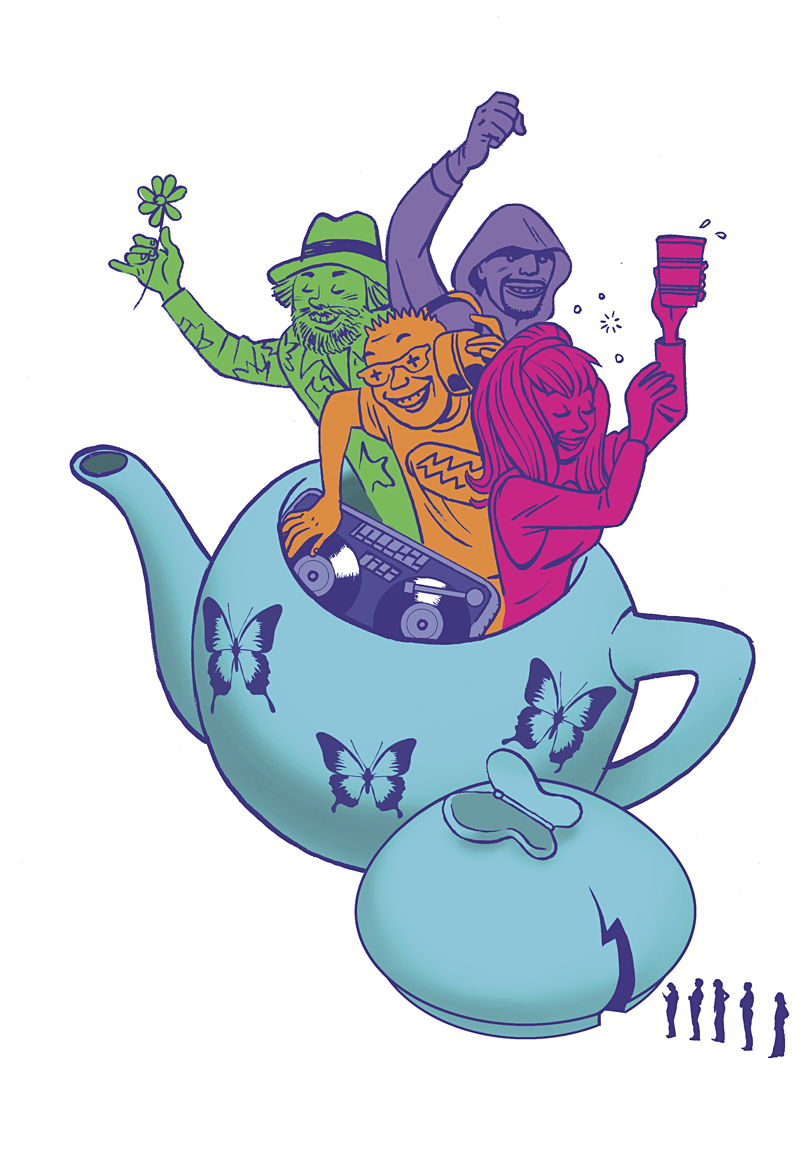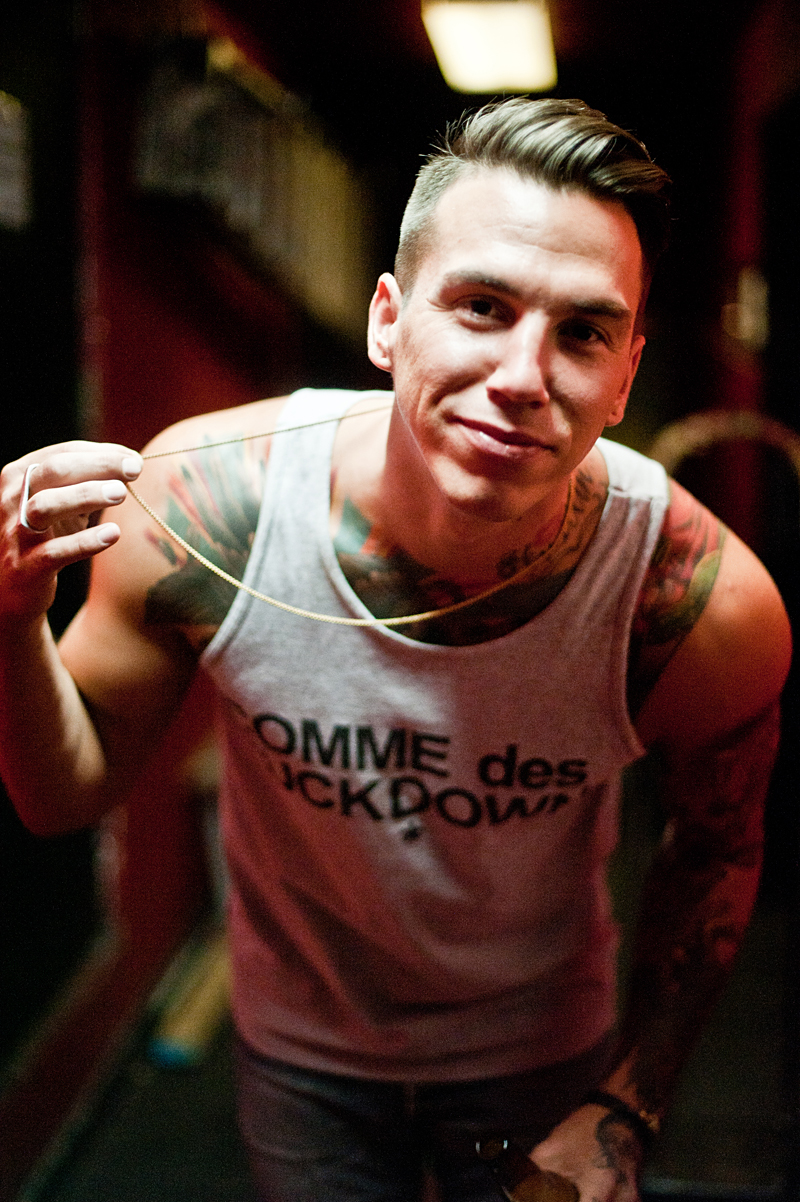On a drizzly Friday night in February, Brooklyn band Cold Cave was playing to a packed, sweaty room at Capitol Hill’s Electric Tea Garden, a small loft space where the low ceilings amplified the show’s crowded feel. An installment of goth rave monthly Second Sight, it was the band’s third sold-out Seattle appearance in the past year, but a far cry from their previous shows: at a packed Neumos (capacity 650) for the Capitol Hill Block Party, and opening for the Kills at Showbox at the Market (capacity 1,130). Tonight, Cold Cave were playing for a capacity crowd of only 150.
Cold Cave themselves were stripped down from a three-piece (formerly a quartet) to a duo—the live drummer was jettisoned, leaving only frontman Wes Eisold and keyboardist/noisemaker Dominick Fernow on vocals and electronics—and they played an abbreviated set, thrashing through just a half-dozen songs in under half an hour. And that was the night’s appeal: Everything about it was small.
They’re not the only ones thinking small lately. A new crop of smaller venues on Capitol Hill and in other neighborhoods are redefining Seattle’s nightlife on a more intimate scale.
A couple of blocks down Pike Street from the Electric Tea Garden, on any Friday or Saturday night, there’s likely to be a line down the block in front of Grim’s—not just for its steampunk-inspired bar or “Butterfly Lounge” mezzanine, but for its loft-level dance-party space, the Woods: a 150-capacity room with exposed-wood walls and floors, its own bar, and a DJ booth perched a ladder’s length above the dance floor. Portland house duo Miracles Club’s set at the Woods for last year’s Decibel Festival got the venue noticed as far abroad as the UK, courtesy of The Guardian.
“The trend to open smaller venues does seem to be what’s happening now,” says Benjamin Sheffield, who’s been booking weekends at the Woods since its opening six months ago. “It makes sense from a financial point of view. If you are responsible for opening the establishment, that’s less of an investment to get the doors open. To me, the size of the room is perfect—it doesn’t take 200 people to make the night feel alive. At the peak hour, the Woods is like a house party. A house party set in the best neighborhood for nightlife.”
More than just size sets such spaces apart; it’s their re-creation of a house-party vibe. Around the corner from the Woods, the Unicorn is finishing construction on a new basement space, as is Neumos down the street. Both are set to open in April, and both are relatively expansive—the Unicorn’s Narwhal Room extends not only below their upstairs bar space but underneath the Post Options mailboxes store next door, while Barboza, below Neumos, will be twice the size of its mid-’00s incarnation as the VIP Room—but both aim to project a unique not-quite-a-nightclub vibe.
“Neumos is a bigger room,” says co-owner/booker Steven Severin. “There’s a lot of bands that we don’t get to work with that I’m a fan of, especially locally. This is a way for us to get to do that, and on Capitol Hill with a full sound system, lights, etc.
“We used to have some killer parties at the old VIP room,” he continues. “We had Justice and Diplo DJ there after their crazy Showbox SoDo show [capacity 2,000]; a Band of Horses after-party with Sub Pop; and even Muse came and threw down there after one of their arena gigs. There’s a big difference when you’re not miles from your favorite artist. You want to feel their sweat coming off of them. That’s what I like the most, and that’s the kind of vibe we’re hoping to create.”
The Narwhal Room aims to keep things intimate by more concrete means. “It is a large space down there for a bar,” says Unicorn co-owner Paul Blake. “It’s two or three times bigger than the upstairs. But it is small for a venue. Capacity will be about 300—and that includes upstairs. It will seem smaller and cozy, though, because we have broken up the space into some separate spaces”—including a pinball room and a main room with one long bar and a stage barely big enough to fit a four-piece band.
It’s not only on the 21-plus bar circuit that smaller spaces have become the loci for music and nightlife. Until it was shut down late last year, the Healthy Times Fun Club, a basement punk venue beneath the Annex Theatre, hosted all-ages shows with a distinctly DIY, communal, house-party vibe. For a suggested donation, a person could catch touring acts, like Lightning Bolt and No Age, or any number of local bands—and enjoy a complimentary vegan potluck beforehand. Since HTFC’s closing, some of that activity has shifted to Cairo, a small gallery/retail storefront space in Capitol Hill’s quieter Northwest quadrant. Though its shows are considerably more low-key, Cairo has become a hub for many of Seattle’s up-and-coming artists and musicians, even earning a front-page profile in The Seattle Times’ arts supplement.
Of course, smaller venues are nothing new; spaces like the Comet Tavern, the Rendezvous’ JewelBox Theater and Grotto in Belltown, or even the Sunset in Ballard have long done big things in little spaces. The Electric Tea Garden space has existed in one form or another since the mid-’90s. And larger clubs continue to thrive: Neumos’ overhauled basement wouldn’t be possible if the main club and Moe Bar weren’t doing good business upstairs, and Q, a 17,000-square-foot gay megaclub, is under construction down the block at Broadway and Pike.
But across the city, some of the best nights out are happening in closer quarters—Seattle’s basements, lofts, and side rooms. Even the Crocodile has recently started hosting smaller events in its Back Bar.
“I don’t know how much of a trend there is towards smaller spots,” says Severin. But on their special appeal, the Neumos co-owner—who’s booked shows from there to the Paramount (capacity 2,800)—concurs: “Personally, I’d rather see shows in a smaller room.”






